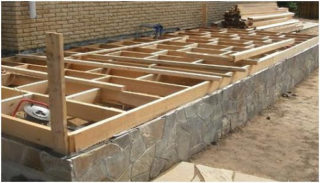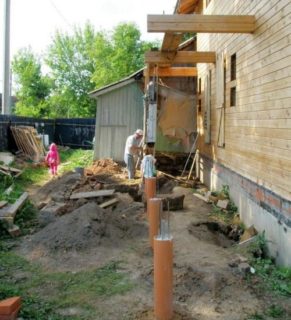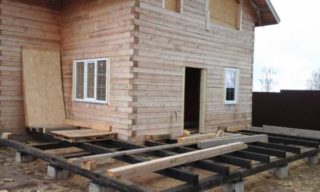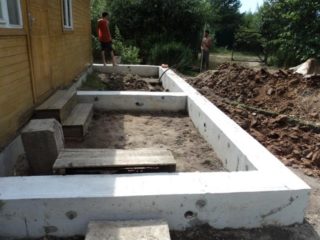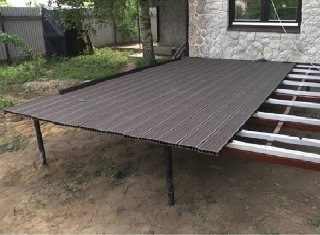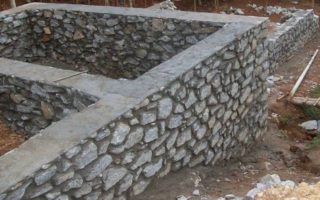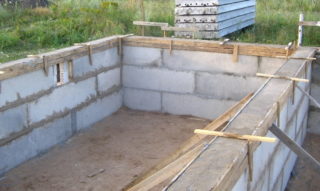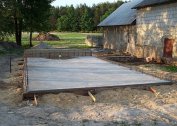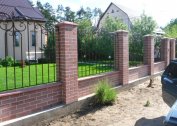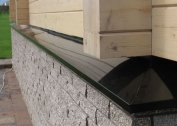The construction of the base is a mandatory stage of installation of various designs. The foundation for the veranda is built according to general rules, but there are some features of the choice of type and materials. Much depends on the nature of the future building.
The need and features of the foundation for the veranda
Compared to the house, the veranda is lightweight, but still it creates a load on the ground, causing a subsidence of the soil. The foundation partially solves this problem and performs important functions:
- takes the weight of the building and distributes it;
- keeps the structure at home level;
- protects from heaving and ground movement;
- protects from moisture.
When choosing the type of foundation should be based on the material from which the construction will be performed, the weight of the structure, the characteristics of the soil.
To avoid problems after the construction is completed, the foundation for the veranda should be done at the same depth as for the house - below the freezing depth of the soil. However, in practice they often build shallow in order to save on materials and reduce labor costs. In this case, it is recommended to choose a design that better resists deformation of the soil.
A freshly prepared base can especially lead after winter. Therefore, it is not worthwhile to tightly tie the foundation of the house and terrace in the first couple of years. Leave a gap of 20-40 cm (technological joint) and bring the ends of the reinforcement from both foundations.
Materials and Tools
Of the tools you need:
- shovel, concrete mixer, mixing tank - all this is required for the preparation of concrete or cement mortar;
- welding machine, grinder, pliers - are needed to fit metal pipes, create a reinforcing cage;
- a drill, nail driver, screwdriver, saw, hammer - will be required for the construction of formwork;
- Roulette is necessary for marking.
A set of materials for the construction of the foundation includes:
- cement;
- sand;
- crushed stone or gravel;
- wire;
- armature;
- roofing material;
- stakes;
- ropes;
- nails.
As the main material can be pipes made of PVC or metal, brick, boards or plywood, cinder blocks, foam blocks.
Types of foundations under the veranda
There are several varieties of the foundation, which are more or less suitable for the construction of the veranda.
Columnar
Column foundation is used for light buildings and soils with good bearing capacity. The veranda is most often built on this basis. Pillars can be made of cinder blocks, bricks, metal pipes, reinforced concrete. The final cost of concrete support pillars for the terrace is one of the most profitable. Brick poles will cost more, since it is recommended to use solid burnt brick.
Tape
There is enough foundation for light construction, deepened by 0.5-0.7 m. The concrete strip is reliable and versatile, but it is not suitable for marshy soils, areas where groundwater is located close to the surface. But even then you can build reinforced options.
Screw
The screw foundation is optimal for heaving, swampy soils. At the same time, it is not suitable for rocky soils due to the nature of the installation. Deep holes for piles do not need to be prepared. There is a screw at the lower end of the support, and it is screwed into the soil, cutting through its layers. This is a complex and expensive foundation, but sometimes the only possible one.
The screw foundation is installed quickly, without the use of special equipment, at any time of the year. Immediately after installation, you can begin construction.
The diameter of the pile is selected in accordance with the future load. For easy extension, screw piles with a diameter of 76 and 89 cm are suitable.
The screw foundation for the veranda cannot be installed closer than half a meter from the house, due to the use of special levers.
From the pipes
When building a column foundation, it is convenient to use pipes from various materials. The role of fixed formwork is played by products from PVC, asbestos cement, metal. This is an economical option for a terrace base. In addition, in the case of PVC and asbestos cement, the formwork is not subject to corrosion. The disadvantages of pillars under the veranda is a relatively short service life - up to 50 years and the possibility of use only for light buildings.
From FBS blocks
The foundation of FBS blocks can be arranged even on complex sandy soils. Such a foundation can withstand a brick building, but the blocks absorb water, so they require careful waterproofing. Considering the cost and labor, they are not suitable for outbuildings. The construction of a foundation from FBS involves the use of special equipment.
Stone
The stone foundation is made from buta - a stone of natural origin. It is durable, resistant to moisture and has an acceptable cost. The stone has increased strength and can withstand significant loads. An important drawback: masonry work is complicated by the need to fit the rubble stone in size. To build the foundation, you need to select clean material and check it for strength with a hammer.
On stilts
The main difference between the pile foundation and the column foundation is that the supports are buried to the ground with sufficient bearing capacity. In some cases, their length can exceed 5 m. An element of a pile-grillage structure is a pile that is buried in the ground, and then they are connected together by a concrete grillage. The main advantage is that the pile foundation perfectly shows itself in any conditions: soil, which is prone to subsidence. However, its construction is associated with significant labor costs.
Concrete slab
There is a possibility of building such a foundation for the veranda, but it is not profitable due to the high consumption of materials, the need for insulation, which generally makes pouring a concrete slab inappropriate.
DIY foundation for a porch
The construction of any type of foundation involves a series of successive stages. If you do not consider each type separately, the process consists of marking, excavation: digging a trench or foundation ditches. Further, the types of work will vary depending on the type of basis. For example, if a porch on screw piles is attached to the house with your own hands, you need to weld the ends to the supports.
Columnar
For a small veranda, 4-6 supports are enough. They are installed at a distance of no more than 1.5-2 m from each other.
- At the location of the posts, stakes are driven in, and then dug holes below the depth of freezing of the soil to the size of the so-called column heel - broadening at the bottom.
- They make a sand pillow: pour about 15–20 cm of sand. Tamp it.
- A frame is constructed from the reinforcement, fastened with a knitting wire.
- The formwork for pillars is made of wooden boards or roofing material. Wooden formwork is used for the construction of square pillars, roofing material - round.
- The reinforcement is placed inside the formwork and the cement mortar mixed with cement, sand and crushed stone is poured in the proportion 1/3/5. It is recommended to fill gradually, while pouring soil from the outside so that the roofing material does not tear.
If the columnar foundation is made of concrete blocks or bricks, the sequence of work remains the same, only the blocks are laid according to the level and after the end of the masonry, the posts must be waterproofed. This type of foundation is optimally suited for a veranda made using frame technology.
Tape
It is advisable to make a strip foundation if the veranda is built of heavy materials: brick, foam concrete.
Step-by-step instructions for completing work:
- The place under the foundation is cleared and a trench is dug around the perimeter. Its depth depends on the type of soil: if the soil is clay, the depth should be about 1.5 m, if it is sandy, 30 cm is enough. The width of the trench should be 20-30 cm more than the width of future walls, plus 5-10 cm additionally.
- At the bottom of the trench, a sand cushion with a thickness of about 10-15 cm is arranged and carefully packed.
- Formwork is made from sheets of plywood, boards or other improvised materials. It should raise about 30 cm above the ground. Wooden stakes are used as props.
- From reinforcement with a thickness of about 1 cm, the frame is connected and laid in a trench.
- Fill the foundation with concrete.
The concrete foundation gains strength for at least two weeks, only then can the building be erected.
Pile
The extension of the porch to the house is easy enough:
- Preparation for construction includes removing the fertile layer - about 20 cm of soil. If the soil is clay, first 10 cm of sand is poured, and then 10 cm of crushed stone.
- Piles are recommended to be installed at a distance of no more than 2-2.5 m. Before installation, drill holes in the soil with a depth of at least 1.5 m.
- Install asbestos-cement pipes in the holes.
- A frame of 1.2 cm reinforcement is placed in them, fastened across with thinner rods.
- Then, the grillage formwork is installed according to the type of strip foundation, vents are made, securing across the pipe formwork and the reinforcing frame for the grillage along. Pour concrete.
Compared with the strip foundation under the veranda, the pile pile is more economically advantageous.
Screw
The screw foundation is installed in the following order:
- The preparation of the territory is not required, therefore, they immediately begin to mark the territory with pegs that will indicate the place of installation of piles. The distance between them should be about one and a half meters.
- The piles are screwed so that about 50 cm remain on the surface. As they are installed, they are leveled to a single level, for example, using a laser level.
- Trim grinder to the desired level.
- Concrete is poured in to prevent metal corrosion.
- Heads are welded to the upper part of the supports, onto which a strapping beam, channel or grillage is then fixed.
The base is not subject to the forces of frost heaving and maintainable.
You can not unscrew the pile for alignment - then it will sag.
Stone
Before the construction of the base, large blocks should be split into parts of 25-30 kg with a hammer and a chisel according to the marking.
- Construction begins with digging a trench. They dig it below the freezing depth.
- If formwork is used, its inner surface is protected by roofing material or polyethylene.
- The masonry is reinforced with reinforcement and broadening is done below. You can make a foundation for pouring, then the stones do not need to be selected in size and time can be significantly saved. In this case, the boot is laid on a sand cushion, the gaps are filled with gravel, compacted and then poured with concrete mortar in order.
The aerial part of the foundation under the terrace can be laid on the mortar, so that the surface looks neat, or pour concrete tape foundation with the help of formwork, after completing the reinforcement.
From FBS blocks
The foundation of FBS blocks is too complicated in construction, it is more suitable for heavy buildings. To lay out the block foundation, you first need to dig a trench, then prepare a pillow of sand and gravel, waterproofing from roofing material and lay the blocks on a cement mortar. They are also waterproofed on the sides and on the top; coating waterproofing can be used for this purpose.
Choosing the foundation for the veranda, it is necessary to determine whether a particular option will be profitable and reliable in the given conditions. Each foundation involves completely different construction costs.
